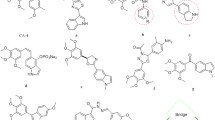Abstract
Novel series of 1,3,4-trisubstituted azetidin-2-one derivatives 8a–p were synthesized and proposed as cytotoxic agents acting via inhibition of tubulin at the colchicine binding site. The design of the target compounds was based upon modification in the structure of the vascular targeting agent combretastatin A-4 (CA-4). The cis double bond linker in CA-4 was replaced with the azetidin-2-one ring aiming to prevent the cis/trans isomerization that suppresses the activity of CA-4, thereby enhancing its antiproliferative activity. All new compounds were investigated in vitro against MCF-7 and HCT-116 cell lines. The inhibition of tubulin polymerization by four most potent compounds 8g, 8j, 8n and 8o was also evaluated. The synthesis of the final targets was achieved adopting Staudinger reaction. Molecular modeling studies were performed to rationalize the biological results.






Similar content being viewed by others
References
Al-Tai AS, Hall DM, Mears AR (1976) Nuclear magnetic resonance spectra of azomethines. Part I. Benzylideneanilines. J Chem Soc, Perkin Trans 2:133–136
Andreu JM, Perez-Ramirez B, Gorbunoff MJ, Ayala D, Timasheff SN (1998) Role of the colchicine ring A and its methoxy groups in the binding to tubulin and microtubule inhibition. Biochemistry 37:8356–8368
Bandyopadhyay D, Banik BK (2010) Microwave-induced stereocontrol of β-lactam formation with an N-benzylidene-9, 10-dihydrophenanthren-3-amine via Staudinger cycloaddition. Helv Chim Acta 93:298–301
Bose AK, Banik BK, Manhas MS (1995) Stereocontrol of β-lactam formation using microwave irradiation. Tetrahedron Lett 36:213–216
Banik I, Becker FF, Banik BK (2003) Stereoselective synthesis of β-lactams with polyaromatic imines: entry to new and novel anticancer agents. J Med Chem 46:12–15
Banik BK, Banik I, Becker FF (2005) Stereocontrolled synthesis of anticancer beta-lactams via the Staudinger reaction. Bioorg Med Chem 13:3611–3622
Cragg GM, Newman DJ (2005) Plants as a source of anti-cancer agents. J Ethnopharmacol 100:72–79
Downing KH (2000) Structural basis for the interaction of tubulin with proteins and drugs that affect microtubule dynamics 1. Annu Rev Cell Dev Biol 16:89–111
Dumontet C, Jordan MA (2010) Microtubule-binding agents: a dynamic field of cancer therapeutics. Nat Rev Drug Discov 9:790–803
Dorleans A, Gigant B, Ravelli RB, Mailliet P, Mikol V, Knossow M (2009) Variations in the colchicine-binding domain provide insight into the structural switch of tubulin. Proc Natl Acad Sci USA 106:13775–13779
Greene TF, Wang S, Greene LM, Nathwani SM, Pollock JK, Malebari AM, Mccabe T, Twamley B, O’boyle NM, Zisterer DM, Meegan MJ (2016) Synthesis and biochemical evaluation of 3-phenoxy-1,4-diarylazetidin-2-ones as tubulin-targeting antitumor agents. J Med Chem 59:90–113
Jordan M (2002) Mechanism of action of antitumor drugs that interact with microtubules and tubulin. Curr Med Chem-Anti-Cancer Agents 2:1–17
Klimczak AA, Kuropatwa A, Lewkowski J, Szemraj J (2012) Synthesis of new N-arylamino(2-furyl)methylphosphonic acid diesters, and in vitro evaluation of their cytotoxicity against esophageal cancer cells. Med Chem Res 22:852–860
Lippert JW 3rd (2007) Vascular disrupting agents. Bioorg Med Chem 15:605–615
O’boyle NM, Carr M, Greene LM, Bergin O, Nathwani SM, Mccabe T, Lloyd DG, Zisterer DM, Meegan MJ (2010) Synthesis and evaluation of azetidinone analogues of combretastatin A-4 as tubulin targeting agents. J Med Chem 53:8569–8584
O’boyle NM, Carr M, Greene LM, Keely NO, Knox AJ, Mccabe T, Lloyd DG, Zisterer DM, Meegan MJ (2011a) Synthesis, biochemical and molecular modelling studies of antiproliferative azetidinones causing microtubule disruption and mitotic catastrophe. Eur J Med Chem 46:4595–4607
O’boyle NM, Greene LM, Bergin O, Fichet J-B, Mccabe T, Lloyd DG, Zisterer DM, Meegan MJ (2011b) Synthesis, evaluation and structural studies of antiproliferative tubulin-targeting azetidin-2-ones. Bioorg Med Chem 19:2306–2325
Ohsumi K, Hatanaka T, Fujita K, Nakagawa R, Fukuda Y, Nihei Y, Suga Y, Morinaga Y, Akiyama Y, Tsuji T (1998) Syntheses and antitumor activity of cis-restricted combretastatins: 5-membered heterocyclic analogues. Bioorg Med Chem Lett 8:3153–3158
Skehan P, Storeng R, Scudiero D, Monks A, Mcmahon J, Vistica D, Warren JT, Bokesch H, Kenney S, Boyd MR (1990) New colorimetric cytotoxicity assay for anticancer-drug screening. J Natl Cancer Inst 82:1107–1112
Suresh R, Kamalakkannan D, Ranganathan K, Arulkumaran R, Sundararajan R, Sakthinathan S, Vijayakumar S, Sathiyamoorthi K, Mala V, Vanangamudi G (2013) Solvent-free synthesis, spectral correlations and antimicrobial activities of some aryl imines. Spectrochimica Acta Part A 101:239–248
Tozer GM, Prise VE, Wilson J, Locke RJ, Vojnovic B, Stratford MR, Dennis MF, Chaplin DJ (1999) Combretastatin A-4 phosphate as a tumor vascular-targeting agent early effects in tumors and normal tissues. Cancer Res 59:1626–1634
Wang L, Woods KW, Li Q, Barr KJ, Mccroskey RW, Hannick SM, Gherke L, Credo RB, Hui Y-H, Marsh K (2002) Potent, orally active heterocycle-based combretastatin A-4 analogues: synthesis, structure-activity relationship, pharmacokinetics, and in vivo antitumor activity evaluation. J Med Chem 45:1697–1711
Wei W, Ayad NG, Wan Y, Zhang GJ, Kirschner MW, Kaelin WG Jr (2004) Degradation of the SCF component Skp2 in cell-cycle phase G1 by the anaphase-promoting complex. Nature 428:194–198
West CM, Price P (2004) Combretastatin A4 phosphate. Anticancer Drugs 15:179–187
Xu J (2009) Stereoselectivity in the synthesis of 2-azetidinones from ketenes and imines via the Staudinger reaction. Arkivoc 9:21–44
Acknowledgments
The authors would like to thank all members of the department of Cancer Biology, National Cancer Institute, Cairo, Egypt, for carrying out the cytotoxicity testing and Dr. Essam Rashwan, Head of Confirmatory Diagnostic Unit, Vacsera, Egypt for performing tubulin inhibitory assay.
Author information
Authors and Affiliations
Corresponding author
Electronic supplementary material
Below is the link to the electronic supplementary material.
Rights and permissions
About this article
Cite this article
Elmeligie, S., Taher, A.T., Khalil, N.A. et al. Synthesis and cytotoxic activity of certain trisubstituted azetidin-2-one derivatives as a cis-restricted combretastatin A-4 analogues. Arch. Pharm. Res. 40, 13–24 (2017). https://doi.org/10.1007/s12272-016-0849-y
Received:
Accepted:
Published:
Issue Date:
DOI: https://doi.org/10.1007/s12272-016-0849-y




